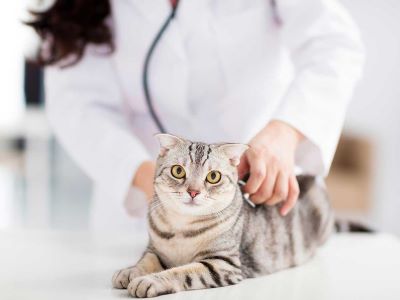Lymphoma in cats can be a big worry. It’s about cells growing uncommonly in the body’s lymph system. Cats of any age or kind can get it. It’s super important to catch it early and understand what is lymphoma in cats.

In this beginning, we’ll talk about cat lymphoma. We’ll learn what it is, how it shows up, and why it’s crucial to take care of cats with it.
Later, we’ll find out how vets figure it out, ways to treat it, and how cat friends can help their cats when they have this issue.
Contents
Lymphoma in Cats?
“Lymphoma is a type of cancer that affects the lymphatic system of cats, which is part of the immune system. The lymphatic system is made of lymph nodes, lymph vessels, and lymphoid organs such as the spleen, thymus, and bone marrow”, says the expert at WebMD.
Lymphoma can affect various organs and tissues in a cat’s body, depending on the type and location of the cancer. Here are some types of lymphoma in cats [1]:
- Intestinal lymphoma: This is the most common type of lymphoma in cats, and it affects the gastrointestinal tract. It can cause symptoms such as weight loss, vomiting, diarrhea, and abdominal pain. Intestinal lymphoma can be large cell or small cell, with large cells being more aggressive and having a poorer prognosis than small cell

- Mediastinal lymphoma: This type of lymphoma affects the chest cavity, where the heart and lungs are located. Symptoms include such as difficulty breathing, coughing, wheezing, and fluid accumulation in the chest.
- Multicentric lymphoma: This type of lymphoma affects multiple lymph nodes throughout the body. It can cause symptoms such as swollen lymph nodes, fever, anemia, and weakness. Multicentric lymphoma can be large-cell or small cell
- Nasal lymphoma: This type of lymphoma affects the nasal cavity and sinuses. It can cause symptoms such as sneezing, nasal discharge, nosebleeds, facial swelling, and breathing problems. Nasal lymphoma is usually large cell and not associated with FeLV infection
Causes and Risks
Lymphoma is a type of cancer that affects the lymphocytes, which are a type of white blood cell that helps the body fight infections. It is the most common cancer in cats and can affect cats of any age, although it is more common in older cats.
The exact cause of lymphoma in cats is unknown, but there are several factors that can increase a cat’s risk of developing the disease. Here are some of them:
- Genetics: Certain breeds of cats, such as Siamese and related breeds, may be more prone to developing lymphoma.

- Viral infections: Cats infected with the feline leukemia virus and feline immunodeficiency virus are at a higher risk of developing lymphoma.
- Environmental factors: Exposure to secondhand smoke, agricultural chemicals, and radon may increase a cat’s risk of developing lymphoma. However, a recent study found no link between nicotine from smoking and lymphoma.
- Age: Older cats are more likely to develop lymphoma than younger cats.
- Sex: Male cats are slightly more likely to develop lymphoma than female cats. please paraphrase this in exact same format
Common Signs
Lymphoma can affect cats in various ways. You should keep an eye out for signs like tiredness, changes in appetite, or swollen glands. Some other signs are:
- Vomiting
- Weight loss
- Diarrhea
- Lethargy
- Appetite changes
- A mass or firm growth in the abdomen

It’s crucial to notice any changes in your feline friend’s behavior and health and contact your vet if you’re concerned. Early diagnosis and treatment may help your cat live comfortably for years.
Diagnosis and Tests
Let’s delve into the process of diagnosing lymphoma in cats, the various tests used by vets, and the essential role that veterinarians play in obtaining a clear diagnosis:
Diagnosing Lymphoma
When your cat is showing signs that something might be off, like changes in behavior or health, your veterinarian steps in like a detective.
They want to figure out what’s going on inside your cat’s body, just like solving a mystery. One possible answer could be lymphoma, but the vet needs to be sure before taking any action.
Tests for Clues
Vets have a toolbox full of tests to help them piece together the puzzle. One common tool is a biopsy. It’s like taking a tiny sample from a lump or a strange area in your cat’s body. This little piece is then studied under a microscope to see if the cells are acting normally or not.
Blood tests are also like little spies, checking for anything unusual in your cat’s blood that might give hints about what’s happening inside. Scans, like X-rays or ultrasounds, can show the bigger picture of what’s going on inside your cat’s body.

The Vet’s Expertise
Your veterinarian is the key player in this puzzle-solving adventure. They know which tests to use and when. They’re skilled in understanding the signs and combining the test results to get a complete picture. Vets also know how to rule out other possibilities that might mimic lymphoma’s signs.
They’re like the experts who guide your cat’s health journey, making sure they get the right treatment if needed. Their experience and knowledge are crucial in getting a clear answer about whether your cat has lymphoma or not.
Why It Matters
Getting a definite answer through these tests is super important. It helps your vet make informed decisions about how to help your cat. It’s like finding the right path on a map. The clearer the answer, the better the plan.
So, while all these tests might seem like a lot, they’re like the tools that lead your vet to uncover the truth and guide your cat toward the best care possible.
Treatment and Prevention
Lymphoma in cats is a typical cancer affecting the lymphatic system, a part of the immune system. Here are some treatment and prevention tips:
- It is most prevalent in the intestines, with reduced occurrences in the chest, spleen, bone marrow, thymus, and lymph nodes due to vaccination and testing for feline leukemia virus (FeLV) and feline immunodeficiency virus (FIV).

- Early diagnosis and treatment are crucial for enhancing the cat’s quality of life.
- Treatment mainly involves chemotherapy, tailored to the lymphoma’s location and grade.
- Chemotherapy drugs can be administered orally or through intravenous injection on a weekly basis for an extended period.
- Surgical removal might be required for sizeable abdominal masses.
- A combination of steroids and oral chemotherapy can lead to over 90% remission of clinical signs in home-based treatment.
- While lymphoma cannot be prevented, the risk of development can be lowered by preventing FeLV infection through vaccination and testing.
- Avoiding contact with infected cats and smoke-exposed areas can contribute to prevention.
- Early detection significantly increases the chances of survival for affected cats.
faqs
Summary
In conclusion, understanding the majority and nature of lymphoma in cats sheds light on the importance of attentive care and bold steps.
By staying informed about the risk factors, available treatments, and preventative strategies, we can contribute to the well-being of our cat companions.
With early detection, the right medical attention, and a commitment to minimizing risk factors, we can aim to provide our cats with the best possible chance for a comfortable and extended life despite the challenges posed by this common form of cancer.
Reference:
- Boldan, M., DVM. (2022). Lymphoma in cats- PetMD.
